#I had to look it up in Vietnamese apparently it's turtle???
Explore tagged Tumblr posts
Text
The way Minthara gets Tav acclimate to poison reminds me of what it's like dating someone from the 'Five-Poison' faction in wuxia novels. There are so many other ways Minthy can get the dosage in. Incense, perfume (smell). Or tiny insect bites that aren't noticeable. Or through skin absorption like coating on clothes, hair, weapons, bathwater, lube, ok I've said too much asdasasfadsa
#minthara baenre#minthara x tav#minthara brainrot#though Kalius would take whatever Minthy hands to her#I think the 5 poisonous animals are snake scorpion centipede spider#but I forgot the 5th one asdasdas#I had to look it up in Vietnamese apparently it's turtle???#for Viet speakers the faction is called Ngũ Độc Giáo#accidentally out myself as a Jin Yong wuxia nerd#colin plays bg3#Minthara x Kalius
43 notes
·
View notes
Text
Safety Found in Red Sleeves
Chapter 7
So, who’s ready for Gotham ft. Thana and friends? Also, Uncles Ed and John show up at the end so, look out for that.
Anyways...
Jason woke up early that next day, and he decided he was just going to have a little bit of a lie in. He smiled and pulled Damian closer, shushing him when he made a noise in protest. “I’m pretty sure the girls are going to join us in a little bit, and then Tim a little while after that.”
Just like he expected, Steph and Cass joined them in the bed not too long after he said it, and then Tim joined in a few minutes after the girls. The five of them laid in bed, everyone finding comfort in each other. No words were passed between the family, they didn’t feel the need to speak.
That’s where Dick and Wally, and their kids, found them about an hour later.
“Why weren’t we called to join the cuddle pile?” Dick pouted and crossed his arms over his chest, while Mar’i, Jay, and Iris ducked around their fathers and climbed into the bed. They, like Damian, chose a Wayne and clung to them. Mar’i clung to Tim, Iris clung to Steph and Jai clung to Cass.
“There’s a nine-year-old practically asleep on my chest. My phone is on my nightstand. None of them brought their phones to my bed.” Jason whispered and carded his fingers through Damian’s hair.
Dick shot a look at Wally, Wally simply shrugged as though to say “when in Rome” before he too got into the bed.
“C’mon Dickiebird. We don’t have anything to do today. We don’t start guiding or protecting them till tomorrow.” Jason’s words were slightly slurred in his comfortable state.
Dick huffed good-naturedly before climbing into the bed with his family and the Wests.
---
Tim’s phone blared from the room he’d claimed, stirring the almost completely asleep cuddle pile into wakefulness.
Jason frowned and shifted Damian from his chest to Steph’s other side. “I’ll be right back. Imma go answer Timber’s phone.” Jason slowly got out of the bed, being careful to not displace the other kids, and quietly left the room. He made his way into Tim’s room, grabbed his phone off of the night stand, and, without looking at the caller ID, answered the phone. “Timothy Jackson Drake’s phone, Jason speaking.”
“Why do you have his phone?” Bruce’s irritated voice came over the line.
“Because Tim’s in my bed asleep with most of my family and he left his phone on the nightstand next to the bed he sleeps in.” Jason’s voice didn’t change despite a grin forming on his face. “If something’s gone wrong at Wayne Enterprises, then shouldn’t you as the CEO be stepping up to solve it? And not your seventeen year old son.”
“You have no-” Bruce growled.
“I have no what? Room to care about my little brother? Right to care that my brothers and sisters would perish in your care?” Jason’s tone took on a deadly edge. “I have killed for less. I have killed to keep my son safe. I am not above maiming in the defense of those I love.” Jason hung up the phone and put it back down on the nightstand with a weighted sigh. He turned and the only indication he was surprised by Cass’s appearance was a slight widening to his eyes. “Hey Cass.”
Cass simply walked towards her brother and let herself slump against his chest. She wrapped her arms around him in her own display of thanks.
Jason simply rubbed circles into the older girl’s back. “I will not let him hurt any of you ever again. Harvey and I will fight tooth and nail if we have to, he has already given up his parental rights to Damian. You and Steph and Tim are just as much my siblings as you are my kids, well, you not so much a kid but you know what I mean.”
Cass shook with silent laughter and nodded. She patted Jason’s back and pulled back. She flashed him a smile before pulling him back to the rest of the family.
---
Jason smiled as Damian ran around the park with Mar’i, Jai and Iris. Damian hadn’t had many opportunities to open up to children his age, as there hadn’t been any in the league, and despite the fact that he was older than the other three the four of them got along fairly well. Jason watched as Dick fretted over the three younger kids, Wally stood beside him with a small affectionate grin on his face. Tim was riding a skateboard around the park, Bart keeping pace beside him. Cass sat with Kon while Steph, Cassie and Cissie chatted a few paces away from the other two.
Damian, Mar’i, Jai and Iris ran around the park, weaving around other patrons and laughing. Damian looked over his shoulder at the other three when he ran into someone.
“Are you okay? Oh I’m so sorry.” A girl, who was with the person Damian ran into, spoke with a French accent. She was significantly taller than her companion with long black hair, the bangs and tips of which were dyed purple, and copper coloured eyes. She fretted over both Damian and her friend, who Damian was finally taking in. Her friend was short, just a head or two taller than Damian, with blue eyes and short pink hair, part of which was pulled back into a spiky ponytail.
Damian nodded. “I’m fine.”
Mar’i, Jai and Iris, upon seeing Damian standing, turned and ran to get their fathers.
The taller girl nervously flicked her bangs out of her face before frowning. “Are you sure you’re okay? Alix doesn’t always look where she’s skating.”
The other girl, apparently named Alix, looked ready to comment when Dick and Wally approached.
“Are you okay Damian?” Dick’s tone was filled with concern while Wally hung back with the three other kids.
“I’m fine Uncle Dick.” Damian frowned, “where’s Baba?”
“He’s gathering the other three, then they’ll be over here.” Dick reassured his young brother/nephew.
Jason ran to his son and scooped him up. “Oh Kutlat Saghira. Are you okay?” He turned to look at the French teens and smiled. “Thank you for stopping to make sure he was fine.”
Alix’s eyes widened before nodding. “Yeah, uh, no problem.”
Juleka gave a shy smile and nodded. “It was the least we could do.”
-*-*-*
Thana stared at her friends, the three who had always had her back and the two newest additions to their ranks. She took a moment to thank Plagg and Tikki, without whom she may never have met her closest friends and allies. She took in her friends and the way that all of their outfits seemed to go together without being obnoxiously matchy-matchy.
Alix seemed to be vibrating in her shoes, which were custom made turtle shell patterned Heelys. She wore dark gray distressed jeans with a dark forest green racerback tank top. She had a black and red men’s flannel over her tank with a red beanie perched on the top of her head. She had a dark green turtle themed shoulder bag strapped across her back.
Nino, standing next to Alix, had similar shoes done in snake skin instead of turtle shell. He wore loose-fitting blue denim jeans with several snake related patches around the side seems, he had a gray collared shirt under a red sweatshirt. He had a black shoulder bag across his back, on the opposite side Alix’s was. He had his normal headphones around his head while he had a pair of black headphones atop his head.
Adrien wore black and white checkered vans with white socks. His pants were salmon with baby pink criss-crossing stripes covering them. He wore a baby pink sweater with a light gray fanny pack.
Chloé wore a layered yellow skirt with a pair of foxes chasing each other around her hem, her skirt was made up of a solid layer of yellow silk under two or three layers of tulle. She had a white crop top tank under a red knit cardigan. She had an orange coloured baguette purse at her side. She had black converse with black socks to finish off her outfit.
Kim wore a pair of black running shoes, with gray sweatpants and a white shirt. He had a red zippered hoodie on top of that. He had a tiny gray ox with a smaller black cat curled up on its back on the hem of his shirt.
Thana had a pair of black running shoes, with gray leggings and a white tank top. She had a red crop top hoodie made of the hoodie she’d received from Jason all those years ago with a few added panels. Her tank top had little depictions of the Vietnamese zodiac animals on her chest.
Alix smiled brighty. “So, Kiti, you’ll never guess who I ran into, almost literally, yesterday.”
Thana hummed in acknowledgement as she led the group to the elevator. “Who’d you run into Rùa?”
“Oh, just, your brother, his brother, and an assortment of children.” Alix grinned as Thana froze and turned to look at her.
“What?” Thana’s voice was almost too quiet to hear, prompting Kim to drape his arm across her shoulders while Nino settled his normal headphones around Thana’s neck.
Chloé stared at Adrien, her blue eyes seeming to stare into Adrien’s soul.
“Hey, Al, that maybe wasn’t the best thing to say when we’re trying to get to the lobby to go on a tour with the rest of our class.” Adrien attempted to gently tell her off, but it backfired.
“Whatever.” Alix slunk ahead of them into the elevator.
---
Adrien looked at Alix forlornly as Alix chatted with Juleka. He knew he’d have to apologize eventually, he may have one fear as Monsieur Punaise (which was his partner) but he had two fears as Adrien Agreste, and they were disappointing his father and an angry Chloé Bourgeois. He shook his head and looked back at Chloé, who had a frown on her face as her eyes continued to scan the streets.
Nino fiddled with his phone as he kept pace a step behind Chloé but a step ahead of Thana and Kim. He looked to be fully absorbed in his phone but he was quick to pull Chloé away from the street a few moments before a car came whizzing past.
Their tour guide, a pleasant man who’d introduced himself as Richard, despite the fact that the bodyguard had snorted in response before neglecting to introduce himself, led them around Gotham. He pointed out all of the touristy destinations, while Thana mumbled what could be considered sad facts about each place.
Thana kept flicking her eyes to the bodyguard, there was only one Gothamite with the exact same build as their bodyguard with the same scars littering his cheeks and jaw. She was worrying the cuffs of her jacket sleeves when she heard the distinctive tap of her Uncle Ed’s cane. She whipped around to attempt to locate him, before seeing him and his tacky suit and her Uncle John and his equally as tacky suit approaching from behind Kim. She broke away from the group, causing the rest of her class (as well as the tour guide and bodyguard) to turn to stare at her as she threw herself into her Uncle Ed’s arms.
“Little Hood. It’s good to see you.” Her Uncle Ed held her close while Uncle John finally reached the duo.
“Hey Mini Todd.” Her Uncle John ruffled her hair before settling an arm around Ed’s shoulders.
The three reunited for a moment under the watchful eyes of the class’ bodyguard, Thana’s friends, and Marinette’s class. Kim pulled out his phone to take a picture to send to his Mẹ, because she had asked for any updates on Thana’s family situation. Nino took a picture to send to Thana, because he knew she’d want to have photographic evidence of when she reunited with her two of her uncles.
“I missed you two so much.” Thana whispered into Ed’s neck while John settled his hand on the back of Thana’s head.
“We missed you too.” John assured their niece, he knew that she’d had doubts about whether or not they had actually missed her as much as she’d missed them, and he hated her father for giving her that complex every day.
Lila let out a blood-curdling scream before appearing to tremble as she pointed at the trio. “Marinette is hugging The Riddler and Scarecrow!” Lila then proceeded to pretend to faint, luckily for her Alya was right there to catch her, unluckily for her everyone else was focused on their classmate and that fact that she appeared to have tears streaming down her cheeks.
Taglist:
@southamericangothamite @maribat-is-lifeblood @mystery-5-5 @our-preciousss @mochegato @chocolatecatstheron @throneoffirebreathingbitch @2confused-2doanything @wannajointhecrabcult @dreamykitty25 @tomanyfandomsonmymind @moonlightstar64 @justafanwarrior @mialuvscats @pheony1882 @pepelachanel @moongoddesskiana @abrx2002 @ladybug-182 @greatcatblaze @thatonecroc @vixen-uchiha @superbwhispersconnoisseur @lilkymilky @susiej1118 @bluesimani @thatonecroc
48 notes
·
View notes
Text
Heritage
I oppose Folkism. I understand Folkism to represent a very ugly parody of the pre-Christian religions that neopagans have been working to revive. I understand neopagan paths to be open. When the old gods call Black or Asian followers, we should let those people answer the gods’ calls.
The reason why I made those statements up-front is that I’m about to delve into a topic whose discussion will require much nuance. I’ve made an effort to write this in such a way as to keep my intentions consistently clear. However, there could still be a possibility of taking many of the following statements out of context, whether by Folkists wanting validation, mainstream people who don’t know much about neopaganism, or Christian-Right propagandists. I’m about to discuss old spiritual heritages of people of European descent.
I may need to touch upon what Folkism is before going on with that discussion. Folkism, in the most basic sense, is the notion that certain old European practices and religions are the sole provinces of their associated cultural groups, whether Celtic or Slavic or, most notoriously, Germanic. It derives from the Volkisch movement which purported to revive Germanic traditions and the people’s connections to their lands. The Thule Society, in particular, laid the groundwork for Nazism. The Nazi regime retained the occultic influences—though I should note they weren’t the dominant strain and the party rose to power by appealing first and foremost to Christian culture (which is yet another historical fact that raises hard questions of what Christianity looks like in the real world).
Today’s adherents of Folkism exploit the discourse around cultural appropriation, though in a mendacious and vulgarized form. Sometimes well-meaning allies do unintentionally vulgarize said discourse as well. One part of appropriation is swiping elements of other people’s cultures willy-nilly—though there are two other key aspects that should be kept in mind. First is the fact that elements of cultures are often taken with little acknowledgement of or gratitude towards the originators. More importantly, there is a context of colonization, marginalization, and erasure.
Even if you haven’t followed me for a while or read my journal entries before, you may be aware of the elements of Asian, African, Native American, and even Jewish spiritualities within the New Age movement. It’s quite clear that a number of people, disenchanted with historic Christian culture for any number of reasons (including extremely serious ones), look elsewhere to find genuine spirituality. Actually, those trends were also present in Europe during the peak of modern imperialism in the nineteenth century, evidently influencing today’s New Age movement.
To my understanding, Buddhists and Hindus are very willing to share elements of their spiritualties—but too often those elements are half-understood, ripped out of context, and watered down anyway. Native Americans have seen their spiritual practices outlawed until fairly recently, which is why they resent those practices being commercialized or taught outside the proper contexts. The Jewish people have faced persecution for many centuries and similarly seen their mysticism suppressed—and they resent mangled or incomplete versions of Kabbalah floating around metaphysical circles.
You may recall the interest that I actually once had in Kabbalah. I did genuinely want to learn from the Jewish people. I had abandoned Catholicism and wanted to learn from its Jewish roots (though I probably underestimated how far Christianity deviated). I was actually ready to start delving more deeply into Kabbalah after reading introductory texts of admittedly varying degrees of quality. I was under the mistaken impression that Kabbalah was now being opened up (though in fact Kabbalah is still considered a closed practice, due mainly to requiring an intensive grounding in Jewish scripture and practice). However, some Jewish users on Tumblr and PillowFort convinced me to rethink my interest. I soon decided that Judaism in general wasn’t for me, much less Jewish mysticism. I didn’t think I could even devote myself to the religious law (however different movements within Judaism interpreted it).
I also had some interest in my own Northern European heritage. That is part of what led me to examine Heathenry in more detail. What finally led me to devote myself to the Heathen path was animism, or a relationship with nature as well as the spirits within and the very powers of life. Sometimes, spiritual practitioners of color heartily exhort white seekers to look into their own ethnic heritages to find their own gods, medicines, rites, and modalities. What ultimately prompted this essay is a video from a healer who goes by “heart of Hamsa” on Instagram; they (I’m using the apparent preferred pronoun) are of Vietnamese and French descent.
They speak of the need for greater respect towards and gratitude for Asian practices. They speak of how they delved into their own heritage. They touch upon the distinctions among cultures and peoples—most certainly not in any exclusionary or purist sense, but in the sense of deepened understanding and appreciation. They speak of a need to give back to the peoples who inspire us, especially in light of colonization, with Vietnam as a prominent example that they cite.
Hamsa goes on to speak of white people who are ashamed or fragile (often understandably, giving rise to the “white guilt” that neo-Nazis maliciously mock) and chase after what they view exotic and foreign, only to fail to do justice to reiki and ayahuasca and the like. They essentially ask people to restart by looking into their own ancestors and uncovering histories. They exhort viewers to set roots and share their own inheritances before looking outside, much less making smorgasbords. Basically, Hamsa asks people to remember who they are and be themselves first and foremost.
How does that apply to a man of Northern European descent born on a land that was stolen from indigenous people? Occasional tweeters will remark that white people have no culture except for banal capitalism and arrogant colonization. Irish, Italian, and German immigrants eventually assimilated into the hegemonic American culture after facing their share of prejudice (my father’s family actually used to be named Koch before becoming Cook during the First World War). The old Christendom may have initially been a union of different Christianized peoples, but at some point (I can’t say exactly when) it became a more-or-less homogenized bloc of Christian colonizers. If even the Irish faced domination at the hands of Englishmen, the Christian European powers were sure to dominate other peoples in worse ways.
Hamsa does speak of “blood” and “bloodline”, which admittedly can raise hackles for good reason. Folkish neopagans also speak of “blood” as in “blood and soil”. Obviously, as you can see from the above context, Hamsa is using “blood” in a subtly though crucially different way. Perhaps, then, Folkism is a distortion of a truth—that truth being a rootedness in personal bloodline and heritage. The kind of “meta-genetics” that people like Stephen McNallen and Stephen Flowers promote is indeed Nazi-leaning bunk—otherwise, learning about the pre-Christian past would not be so difficult or involve so much ambiguity and guesswork. I can accept that white supremacy has influenced the pagan revival to some extent, particularly in its early stages. Did the original Volkisch movement deal with the trauma of enforced Christianization (and the later rise of an increasingly ruthless capitalism) in a very unhealthy way? I don’t have enough historical education to really answer that.
In any case, I’m very pleased to see neopagans seriously work on disentangling that influence. Improved historical scholarship in recent times has been a blessing. Perhaps European-Americans who take the time to learn from such scholarship as well as experienced practitioners might find many boons. It’s possible that the old gods of Northern Europe called me back into their embrace. Indeed, as I began to seriously consider training myself to be a magician working with Odin and Freya, I began to get a sense of a homecoming. My Scandinavian, German blood, and Anglo-Saxon bloodlines ultimately aren’t major factors, but they still are factors in a homecoming. While figuring out a spiritual path, I increasingly wanted to work with divine power as a magician—it turned out that I wouldn’t do so through Kabbalah but through animistic Heathenry.
The question of what a settler is supposed to do among the many settler communities on a continent stolen from its original inhabitants remains. I most certainly have a responsibility to those who lack what privileges I have. I hope to find stronger opportunities to aid the indigenous communities, especially those within the Great Lakes, the region of Turtle Island where I live. For that matter, I hope to find stronger opportunities to aid other communities.
In general, I understand a need to participate in the work of decolonization in some manner. I understand a need to take part in breaking down what has become whiteness. Those who think that they are being broad-minded in taking from so many cultures (and I would have also thought so even a few years ago), it seems, unintentionally contribute to colonization and white privilege. Maybe I will start learning from other peoples after gaining a very firm grounding in a revived Germanic magic, though maybe they will tell me to keep up with that. There are indeed many different paths for people to take to the divine. Some of them are closed (or at least require formal initiation) for very good reasons. Kabbalists and Jewish mages deny that Judaism is for everyone—they might speak of other gods who call to their peoples while the presence of the supreme Godhead remains with the gentiles. People like Hamsa speak of honoring and reinvigorating diversity among the human shards of divinity within today’s world. Thus, demagogues who fearmonger over the One World Religion for the New World Order show themselves to be paranoid fools. There certainly isn’t a Jewish conspiracy to take over the world!
I will take my time in building relations with Freya and Odin, contemplating the runes, training myself to connect to Yggdrasil, and looking forward to meeting elves and various ancestors who have walked my path before. I hope to be of great service as a Germanic magician among the Great Lakes. I also wish to gradually build up stories of diverse people seeking truth, goodness, beauty, joy, and spirituality as a novelist (and possible comic artist). I struggle with lethargy and a troubled heart, but I do believe that I have a calling. You are all welcome to support me and, perhaps better, find your own mystic paths.
#spirituality#cultural appreciation#paganism#heathen#pagan#long text post#mysticism#social justice#colonization#religion#magic#text post#personal essay#writing
18 notes
·
View notes
Text
If I were doing the Avatar Remake
Just a list of things changes and tweaks to the original I would make to Avatar if I was in charge of this netflix remake, given that we’ve all lost hope in it and now I’m just speculating to make myself feel better. I’ve already made a list of things it really needs, and this list includes them, but I’m just going to go hog wild with my imagination and opinions on Avatar. In a rough order of when I think and them and what episode it becomes relevant.
How long are these new episodes going to be? I’d like to extend them for more story content, though am wary of overdoing it. How does thirty minutes sound? Enough for some more depth to some episodes.
I think it should be pointed out earlier on that there are more villages across the South Pole. This is canon, and would make the Southern Water Tribe feel more alive.
Aang’s friends from the past: in addition to Kuzon and Bumi, give him a Northern Water Tribe pal. He’s never been to the South Pole, and was deliberately coming to make new friends somewhere the Monks wouldn’t think to look for him. We can reference this friend again when we reach the North Pole.
Somebody, probably Iroh, mentions Zuko’s name in front of Aang. It’s always infuriated me that the Gaang know’s Zuko’s name suddenly in Warriors of Kyoshi without anyone telling them what it is. I don’t think it needs its own episode, just somebody says it while he’s captured.
The terms of Zuko’s banishment don’t restrict him from the colonies in the Earth Kingdom, so they don’t consider those colonies to be proper Fire Nation territory. I feel they should have their own name, just to make the politics of the show feel deeper. “The Eastern Protectorate” is a nice reference to the Chinese “Protectorate of the Western Territories.” Zhao can namedrop it when they go to his port.
The fact that Kyoshi Island has such a different culture from the main Earth Kingdom should be brought up. The answer is a mix between isolation and cultural exchange with the Southern Water Tribe. Katara and Sokka probably have a passing knowledge of the island. “Oh, that’s where we are.” Also, if Aang knew to come here for the Koi fish, how didn’t he know about there being Kyoshi revering settlements there?
There should be an adult Kyoshi Warrior training the others. She approves of Suki training Sokka, and comments on the rarity of outsiders and men being Kyoshi Warriors. I feel Sokka is the first outsider, but there was another man. Adult warrior gives the explanation that when she was a young trainee, a man working on the docks was teased for “fighting like a girl” so warriors taught him exactly like a girl.
There should be an Earthbending Kyoshi Warrior. I mean Kyoshi herself was a bender, the art can’t be exclusively a non-bending form.
Maybe point out that there are multiple villages on the island. This is in fact canon.
Haru’s mother and village could use some actual names.
We never see any non-bending Earth Kingdom soldiers. I loved how the Fire Nation has different uniforms for its bending and non-bending warriors, and I’d like to see the same for the Earth Kingdom troops.
I want to know more about those pirates? The captain is ethnically a Fire Nation citizen. Is there a story behind that? A navy deserter? Like an opposite of Jeong Jeong, deserting not for ethics but because he didn’t like duty getting in the way of fortune? I’m probably just overthinking it.
The names of the Freedom Fighters are obviously pseudonyms, and Jet probably urges the Gaang to adopt some themselves.
While I don’t actually feel that Aang lying to the two groups in The Great Divide is an unforgivable wrong, I feel the lie itself was a little demeaning and could have been a little more sophisticated.
I have seen that post saying there needs to be more Indians in Avatar than just Guru Pathik, given how many Indian concepts are in the show. Many people also share the opinion that there should be Indian airbenders, so yes they should appear in the flashbacks in The Storm (and The Southern Air Temple as well). Also some Earth Kingdom villages should be Indian based as well. I think the market from The Waterbending Scroll could be a good place to start, maybe the port from The Storm as well, though probably somewhere that isn’t just a background place as well. Maybe the nuns in Bato of the Water Tribe too.
Iroh could be less creepy with June.
Ah, The Northern Air Temple. Honestly I feel that while the ultimate message of Aang being okay with the Mechanist and his people settling in the Air Temple is okay, I feel it needs to end with a greater emphasis on the Mechanist’s people being more respectful to the site. Ramming pipes through historical mosaics and demolishing statues is really not on. Also, while Sokka being cool with industrialisation is in character, I do think he’d disapprove the desecration.
I feel the fact that a lot of the Fire Nation’s technological might (not all of it, though) is riding off the back of a blackmailed Earth Kingdom citizen is something that could be brought up more often.
Yue’s story with the Moon Spirit needs to be explained almost immediately, so that it’s not kind of an arse-pull when the plot needs it.
Legend of Korra makes a big deal about the South gaining independence from the North, but they’re already treated as separate nations? I think it should be mentioned somewhere, probably from Hahn, that the South is technically subservient to the North, though operates with a great deal of autonomy that comes with not being able to contact each other.
The North is pretty sure it’s the original Water Tribe, but can’t say for sure. Hahn thinks of the South as nothing but a colony, though Arnook is more progressively minded and notes there are no records of who came first and treats the South as a sister tribe.
I think there’s another character worth adding, a captain of the Northern warriors. He can appear several more times throughout the series, which I’ll elaborate on.
Zhao comments “there’s a reason they’ve survived a hundred years of war” whereas other comments suggest the Northern Water Tribe has been sitting out of the war. Apparently the North did take uniforms from soldiers 85 years ago, so I think the idea should be that they received one big siege back then, and since then they’ve been experiencing raids since then culling their villages and forcing them into that single fortified city-state. Since then, their ability to send ships out has been impeded by Fire Nation ships patrolling those water but not engaging the city itself until Zhao’s siege.
Yue, when mentioning the waterbenders learning from the Moon, should reference humanity receiving bending from the Lion Turtles, just to introduce the concept that bending could be given and therefore by implication taken away.
There’s a historical character I want to introduce: an Earth Kingdom general that was nearly able to push the Fire Nation out of the Earth Kingdom around half-way through the 100 Year War, but was taken down by internal Earth Kingdom politics. The Fire Nation had to do its conquests all over again because of him. It would help fill out a century of history that is poorly explained. I think he could be introduced by Sokka asking General Fong how they still have an outpost on the west coast when most of that region has been occupied by the Fire Nation.
Azula’s blue fire should be depicted like blue flames are in real life: very straight jets rather than the flickering things you see in the animation. Since it’s basically just powerful fire, I think it should be seen with a couple of other firebenders, though Azula is the only one that exclusively uses it. Jeong Jeong and Iroh would be good people to use it.
I saw a post once by a Korean rightfully upset that the only Korean characters in the show (Song and her village) are lumbered in with the essentially Chinese Earth Kingdom as if they’re the same culture despite Korea obviously being separate and having a poor history of China attempting to enforce hegemony over it. I think maybe something could be made of Song and her people being a distinct culture that has had a generally poor relationship with the Earth Kingdom at large. Maybe the previously mentioned Earth Kingdom general was screwed over for being of this culture.
I’m not sure how to depict the Swampbenders. They'll no longer be caricatures of the guys in the next studio, so they’ll be more respectfully treated and not hillbillies. I’m not sure if they should be Vietnamese (given the original characters have Vietnamese names) or southern Native Americans (given they’re waterbenders, and the other waterbenders are Inuits).
After failing to get Bumi as Aang’s earthbending teacher, they throw around suggestions. Since Aang is learning waterbending from Katara they consider a similarly aged Earthbender. Katara suggests they go find Haru, while Sokka suggests the earthbending Kyoshi Warrior I mentioned before.
I saw a post once suggesting that the Beifongs were collaborators, and while I think this is somewhat extreme, I would like to explore the interplay between their wealth and their position in the war. Also, the fact that Toph had been sheltered from the war and has far less of an emotional stake in it needs to be explored in more detail.
In the Zuko Alone flashbacks Azula really needs to be made out as a normal child with a bad influence (her father) instead of an inherently bad child. My sister points to this episode and claims Iroh or Ursa should have just drowned her and that’s something incredibly fucked up to say about a ten(?) year old.
In that vein, Iroh’s “no she’s crazy and needs to go down” line really needs to be changed to something more compassionate. Most Avatar meta states that Iroh doesn’t actually hate Azula; he’s just prioritising Zuko’s safety, and his line here needs to reflect that.
Aang should recognise the Lion-Turtle, and know that they gave humanity their bending powers. Just to keep that concept in mind, so that when it comes to the energybending climax it’s less of an arse-pull.
Wan Shi Tong’s morale compass and lumping a bunch of kids attempting to avoid genocide in with conquerors needs to be called out more, and I feel Katara should be the one to do it.
Suki gets to stay on for one extra episode and help fight the Drill. It also makes for a better explanation of how she got back. Right now it’s implied she went back across the Serpent’s Pass; in my own she’d explicitly head along the wall and go back with the ferries.
I want more discussion of Ba Sing Se’s social stratification. Was Jin able to visit the Jasmine Dragon? Or was she blocked from entering higher rings?
Toph’s lie detecting thing made into a spiritual or chi related thing. The whole heartbeat thing is pseudoscience.
The Northern Water Captain I mentioned earlier reappears, having met and joined his men with Hakoda’s. Hakoda praises his son with helping bridge the gap between the two water tribes.
Ty Lee gets more appearances in Book 3, even if just in the background. She got some nice development in The Beach and I want to see more of it as Azula’s brought her out of that circus and back into the Fire Nation nobility.
Sparky Sparky Boom Man’s tattoo has a different design that is not a villainised appropriation of a Hindu symbol. Something nice and geometric, maybe sun based.
Hawky at some point returns to Team Avatar. I want them legitimised as a member of the Gaang! Equal status to Momo and Appa! Also I suppose bringing a letter back from the Beifongs could have significance to Toph. But let Hawky return!
Hama has a more compassionate ending. I feel after she’s led away, Sokka figures it’s pretty fucked up that they’re handing one of their own over to the Fire Nation so they go and rescue her. They give her a choice between joining them to fight during the eclipse or returning to the South Pole to help rebuild the Southern Water Tribe (given that there’s Notherners helping rebuild she could help make sure they rebuild it in the style of the south and not a facsimile of the north). She chooses the latter.
No weird Guru Pathik during Aang’s hallucinations please.
While discussing the allies that Hakoda picked up, he mentions some people he couldn’t get: they couldn’t find the Kyoshi Warriors, the Sandbenders didn’t want to come, the Omashi Resistance wanted to use the eclipse to retake their city, and General Fong’s outpost had been overrun. Just flesh out things a little.
Sokka and the other Water Tribe warriors should be wearing that facepaint for the Invasion.
I want more interaction with The Duke, Haru, and Teo with the Gaang.
Chit Sang’s girlfriend and friend join with the second escape instead of being strangely absent. Also, who is he? Sokka probably looks him up to make sure they’re not bringing a serial killer into their midst. Preferably not, I like to think they were thrown in there for opposing the war.
I’d like Suki to learn from Hakoda that the other Kyoshi warriors are alive, if imprisoned.
Suki doesn’t like wearing prison clothes and attempts a facsimile of Kyoshi islander clothes by stealing Katara and Haru’s clothes.
Some more emotions between Sokka and Suki relating to her imprisonment please. There’s a lot of pent up trauma there and I’d like them to work through it.
People like to play up Katara’s “you obviously didn’t love her as much as I did” line into an insight to a horrible character rather than just something stupid said in the heat of the moment, though I do think Katara should apologise, if only to show the haters that this isn’t her personality.
Training with Aang, Zuko finds out he has the peace of mind to do lightning. He wouldn’t use it against Azula, but it would be a nice demonstration that his inner turmoil is more or less resolved.
The adult Kyoshi Warrior I mentioned at the very beginning of this reappears as a White Lotus member. She, for whatever reason, has a replacement warrior uniform for Suki, because I feel Suki shouldn’t have to go through the climax in a Fire Nation disguise. Also maybe Sokka should be wearing his warpaint too? I mean it’s culturally significant to him.
You want lightning? No I don’t. Azula’s growing inner turmoil denies her the use of lightning, mirroring Zuko’s original inability to use it when he was lost and confused. So when it comes to sneakily zapping Katara it’s just her fire, but a flame more concentrated (and by implication, rage-fueled) than we’ve ever seen from her. A veritable beam that Zuko has to put his all into deflecting, opening him up to an attack. A non-lethal attack; Azula still has that line about “the family physician”. She doesn’t want Zuko dead and leaves him be when he’s down. Despite going off the deep end there is a spark of compassion in her that stops her from doing that.
As I’ve stated previously, Aang needs to do something slightly more significant and spiritual in order to access the Avatar State again rather than that stupid rock. Some sort of spiritual lesson.
As I’ve said a few times now, the Lion-Turtles should be known to the audience by now, along with their ability to give bending to humans, so that the ability to take bending has been implied.
The weird orange-vs-blue lightshow with the energy bending was kind of melodramatic, though the corruption-vs-purity thing could still be visually represented by Ozai trying to physically overpower Aang and failing.
Possibly to be continued.
8 notes
·
View notes
Text
Seoul Train!
There was no train. I debated with myself whether to go with “Seoul Survivor” or possibly “Save my Seoul” but went with neither to the relief of many. But I did enjoy my short trip to the Korean capital, and drove myself to brankruptsy in the process. They have cute clothes, what can I say.
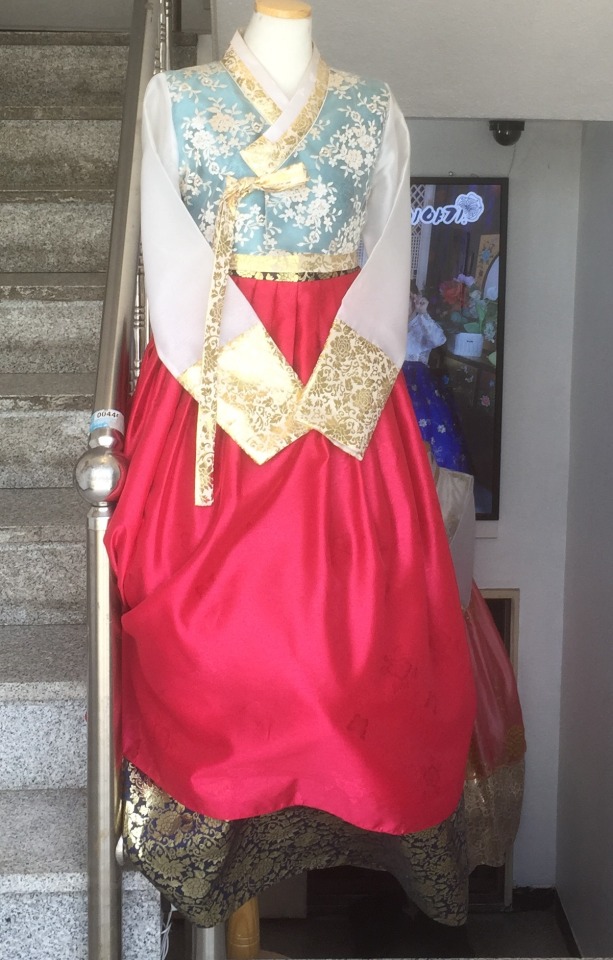
^ This is a traditional Korean outfit called a Hanbok. There’s a male version too, but the female one shown here makes the women who wear them look like princesses. <3 Also, there were a lot of variations on this, and not everyone was wearing one, just to be clear.
I went on this trip to Korea to see Seoul, and that’s it. I was really tired from going to Hong Kong, so I decided to chill and only visit one place. Consequently, I know that what I saw in Seoul is probably not going to cover what all of Korea is like. Anyways.
I was really excited to see some the famous Korean skin care stuff and wasn’t disappointed. As soon as I flew in I started walking around the city and found a chain store that sells a ton of awesome skin care stuff.
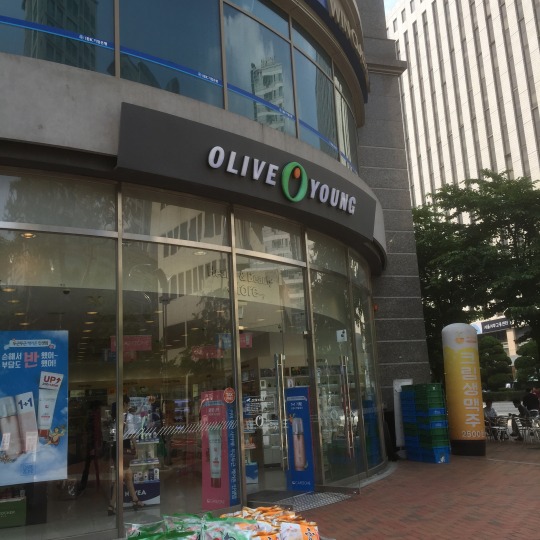
^ This is the store. They, and others like them, are everywhere.
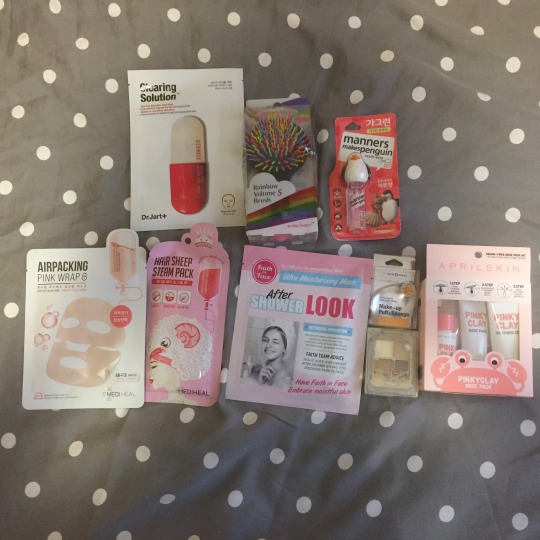
^ This is the stuff I bought. ‘Spensive.
Walking around in Seoul is like walking around in most large cities, and Seoul is very modern. It has a ton of hills though, so come prepared to get some legs. It’s not as bad in this regard as Hong Kong, but still nothing to shake a stick at.
I decided to walk around and explore the subway, and before long it was getting dark and I needed to get to my airbnb accommodations. After miles of walking and confusion, as I seem to enjoy doing things, I asked my host, Lydia, where she lived and then my phone promptly died. I found an outlet eventually which let me charge it a bit, and then mooched off of a Starbucks’ internet in the witching hour (I will forever love Starbucks because they always pull through), and found my way to a charming historical neighborhood.
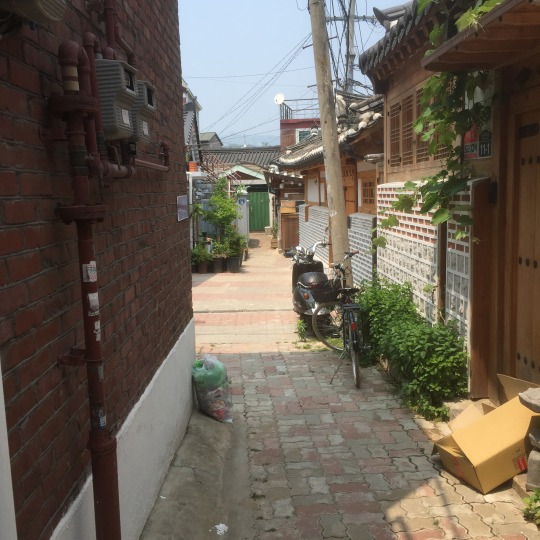
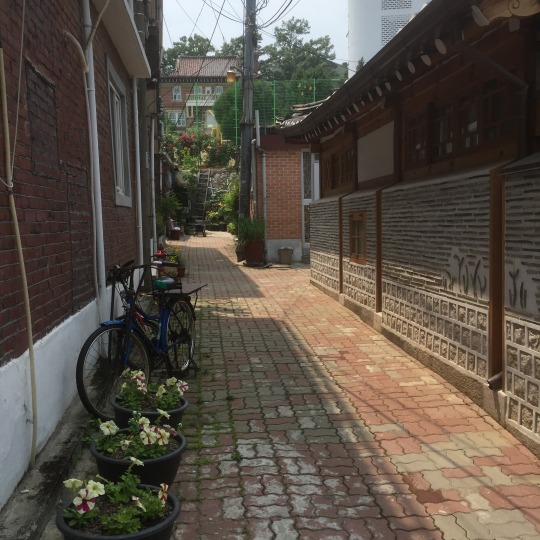
^These neighborhoods are supposed to be very similar to how they looked a hundred or more years ago. Also, this is what they look like in the day, not when I originally flopped into them at the same time of day a navy seal starts a raid.
So I finally found the place, and Lydia was fairly upset over what seemed like my untimely midnight demise, which was nice of her since she didn’t know me yet. She was still a little upset though, so we decided to get drunk on some random wine she had, which is often a good solution to problems. It also turns out she speaks both English and Korean. Heckin cool. Sadly, I forgot to take a selfie with her like I normally do when I randomly meet people, but that’s alright.
Anyways, the next day I woke up in Lydia’s house, not dead, and decided to go to Itaewon, which is famous for having really good, cheap tailors. Apparently you can get a whole suit made from scratch for under a hundred dollars. I didn’t have time for anything so elaborate, but I did get a couple vintage dresses altered. They have a lot of cute vintage clothes here and I have no idea how they have so many. Maybe they were originally made in Korea or something.
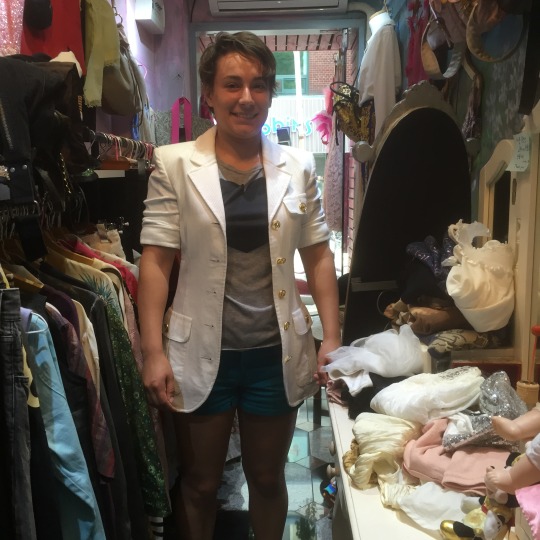
^ Me standing in a vintage clothing shop wearing an extra small dress as a jacket
I ended up exploring an area that had a lot of British antiques. Like most cities, you can find stuff from everywhere, but the focus was a little different. The Japanese and Vietnamese seem enamored by the French, but in Seoul it seems that the trendy foreign group is the Brits. I stopped and had lunch at a Radical British Vegan cafe, and looked out the window.
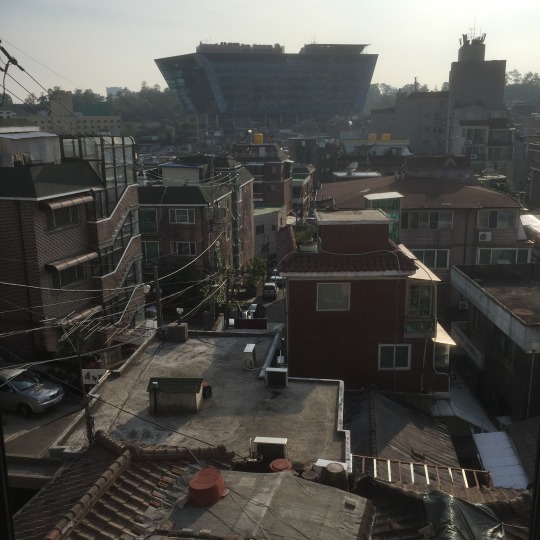
^ Out the vegan cafe window
I hopped back on the subway to go see an old palace, and they were selling these bags of soft dough fish with filling in them on the subway, so I bought a bag despite having already had lunch.

^ The last small dough fish from the subway.
The Palace and Museum
The palace and the museum next to it were a really cool look into Korea’s past. I was extremely impressed by how well their documents were stored and preserved. Notebooks from centuries ago looked fresh, like they were made recently. Apparently the royal family that ruled the longest had a council of people that would record every single thing that king ever did, so that when people looked back on that period of rule, they would know if the king did a good job. The king was never allowed to see what they wrote about him and the council was supposed to be as objective as possible.
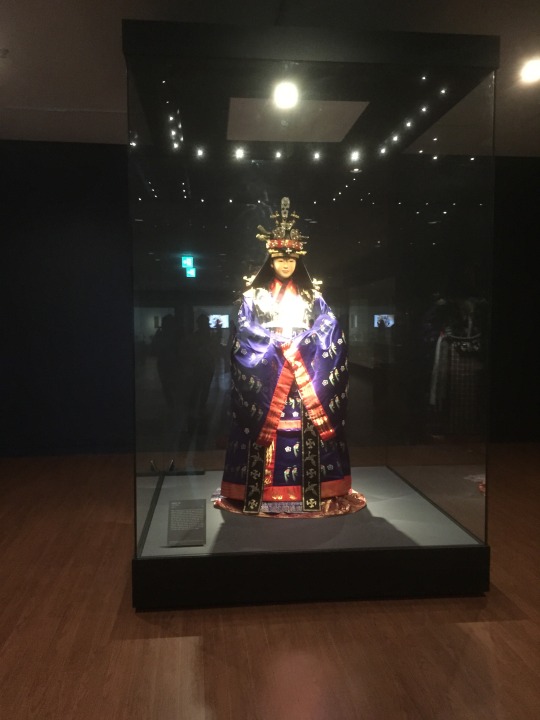
^ This is what the queen wore.

^ Apparently this mountain in the background is very important for cultural reasons. The buildings are positioned to give prime views of specific mountains, and when the Japanese invaded, they moved every building a few inches to ruin the view. The Koreans, upon the departure of the Japanese, moved everything back.
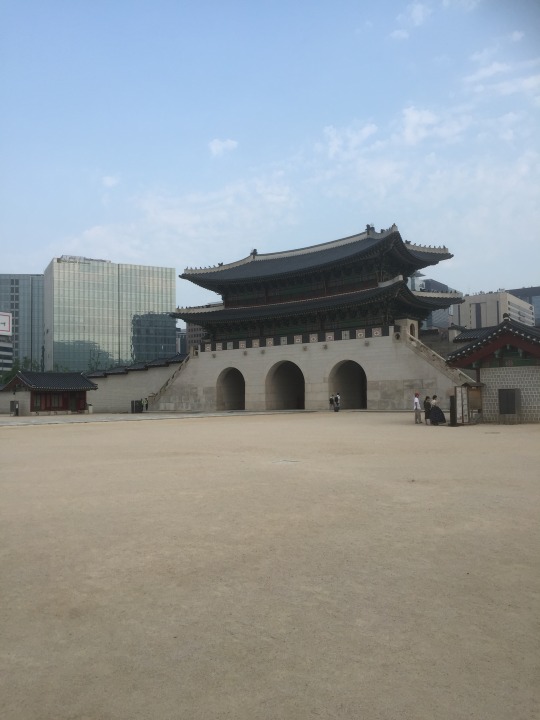
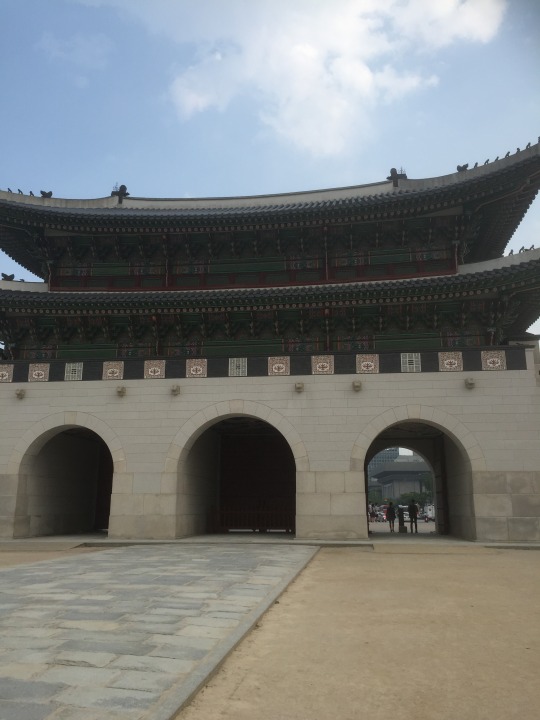
^ This is the gate.

^ People in Hanboks entering the main palace area
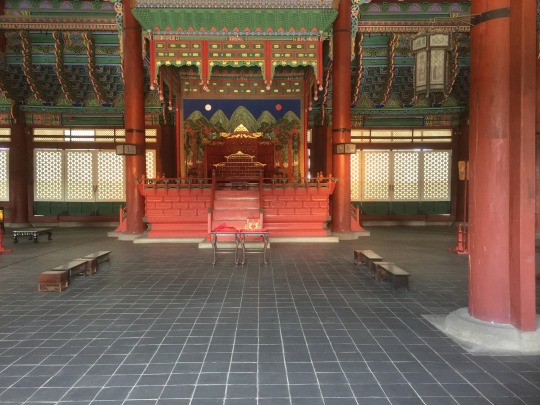
^ This is the throne room. It doesn’t look comfortable to me, but apparently the king was supposed to be a nerdy intellectual type so maybe he found pillows and back support distracting.
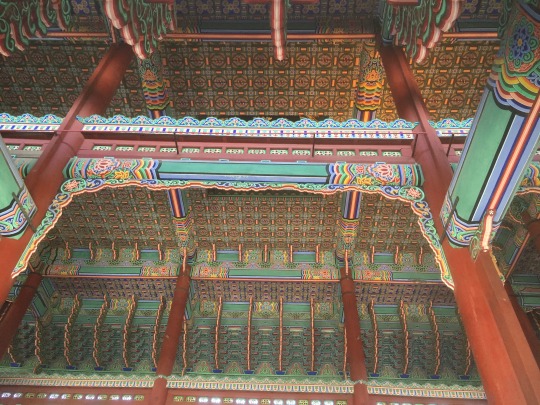
^ This is the ceiling of the throne room.

^ Other buildings to house people that were not the king
After seeing the palace, I went to a small area that talked about the average Korean, centuries ago. They lived in small wooden houses.

^ Small peasant house
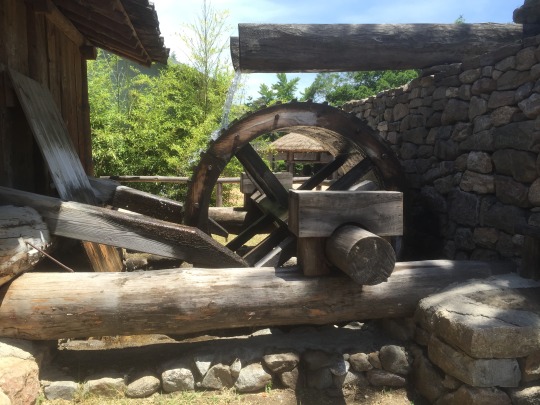
^ Some sort of water pump for the peasant house
Walking Around
So after exploring the palace and related areas, I walked around and went through some alleys.
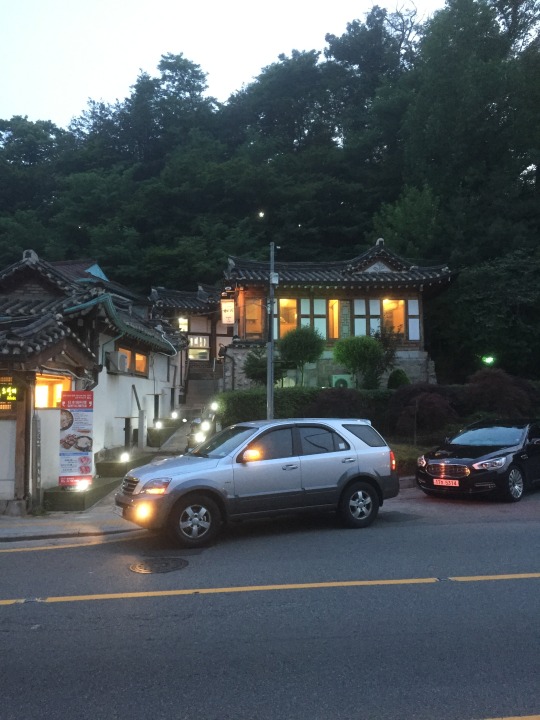
^ Random restaurants
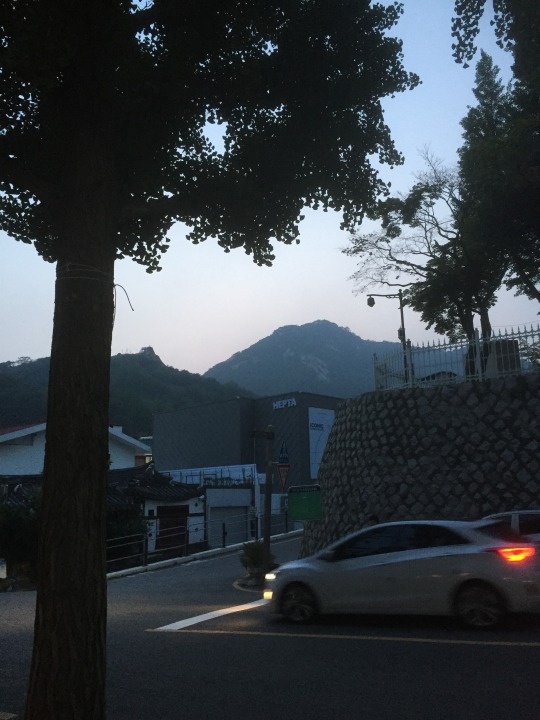
^ Hilly roads
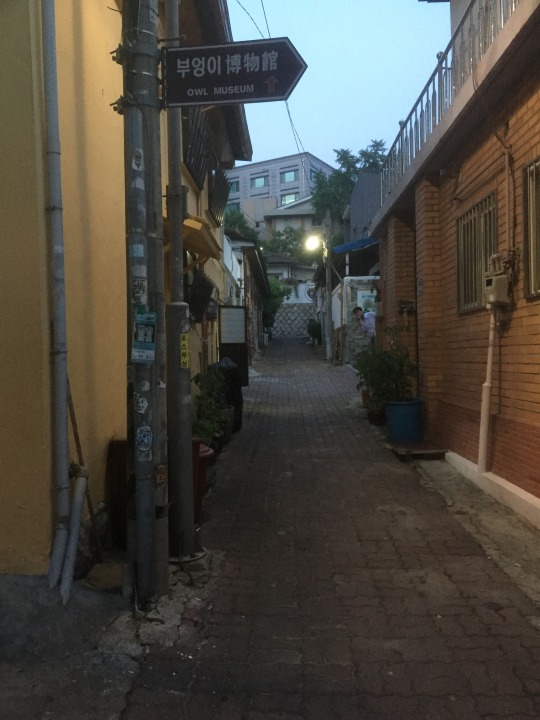
^ Tried to find this owl museum, but they were closed past 8pm. Not a museum for night owls I guess.

^This is on the side of the owl museum. Talk about getting me excited for no reason.

^ What’s this? Oh nothing, just an unreasonably steep hill full of shops.
The next day I walked around a different area that had boutique type stores.
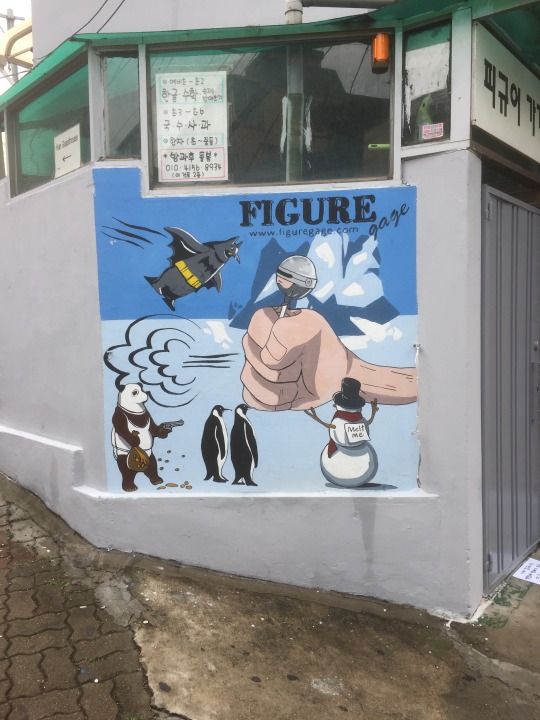
^ This was on a wall. I thought it was neat.
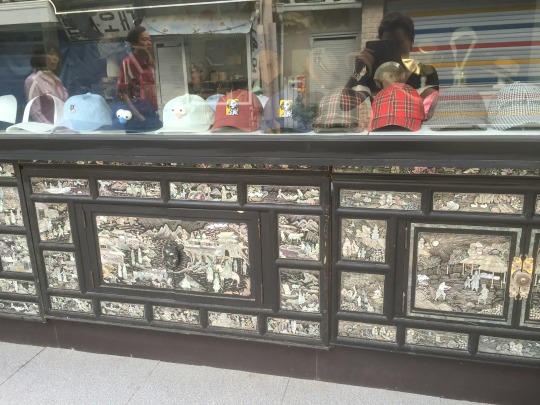
^ I walked past this store that had some very elaborate art beneath the window that looked like it was made of wood and maybe opals or something else shiny. It was the kind of thing you really should encase in glass.
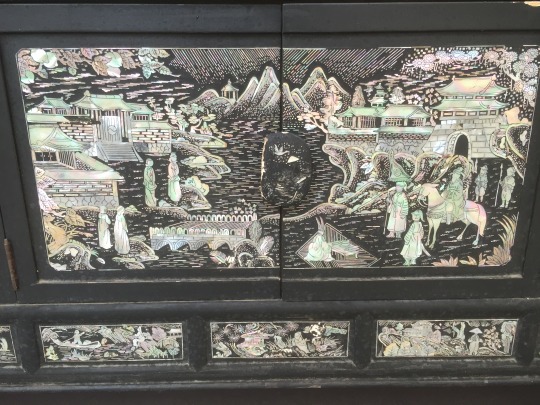
^ It’s kind of hard to see the shiny colored parts in the picture, but it looked like some sort of shell or opal material. I have no idea how anyone would make this.
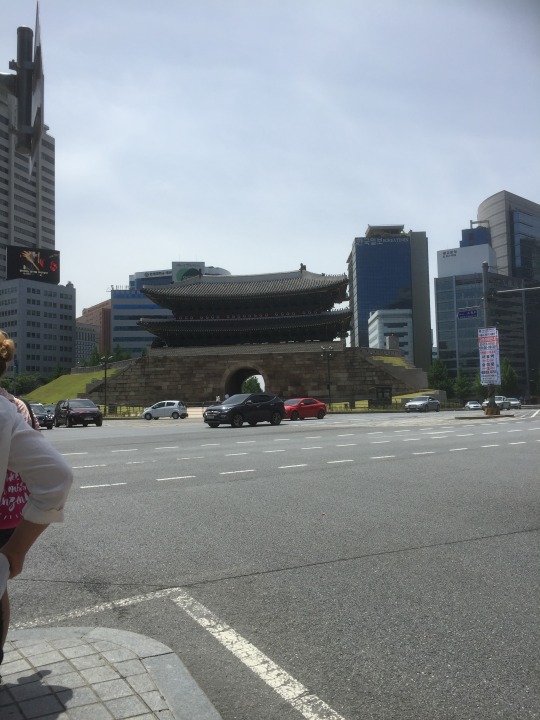
^ Some random gate to nowhere in the middle of an intersection. It probably used to be part of a wall enclosing Seoul.
A Couple More Things
Lydia asked me if I wanted coffee or tea one morning, and decided to make an ancient Korean delicacy that involves mixing tea and coffee into a strainer together and pouring hot water into it so that you get an equal measure of tea and coffee. Not really, she just got extremely confused when I asked for tea and accidentally put tea in her own strainer along with her coffee. But we can pretend.

^ Is this covfefe?

^ I saw this TURTLE SHIP in the gift shop at the airport. I almost had a stroke.
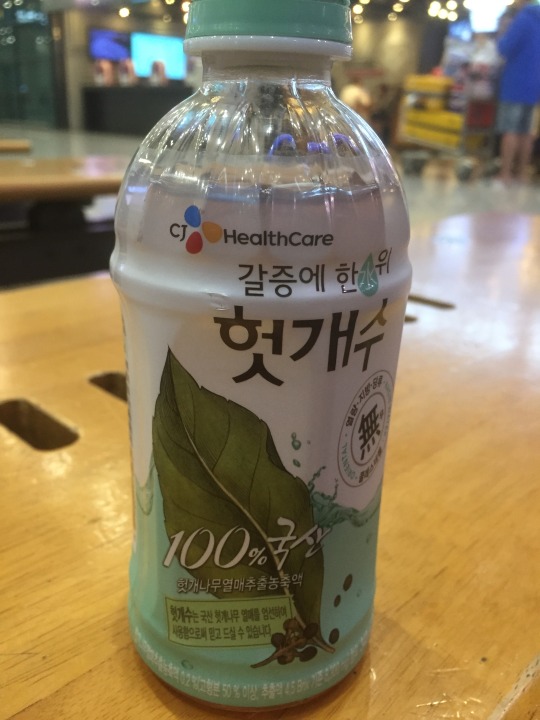
^ This is raisin water. It has a taste like nothing I’ve ever tried. It’s kind of nice.
1 note
·
View note
Text
Day 2: Cuc Phuong National Park and Hanoi
We are still a little jet lagged so before breakfast I did a mini ab workout. We ate early today and departed our hotel with Thoi at 730am driving toward Cuc Phuong National Park, one of Vietnam’s 11 national parks. I always love these long drives where you get to see life outside the main city. We drove through another city with considerable construction and new buildings including some pretty ugly new family homes made to look like flamboyant old french buildings complete with domes.
As we get closer to the park, where the road is no longer paved, wet rice fields flank both sides of the road. Water Buffalo, brown cows, and countless calfs dot the country side. People zip by in their scooters and one man hits a goat. We’re witness to one of the many (20000 a year or more) dangerous scooter accidents that Vietnam sees daily. Passengers from a nearby rush out to assist him. The landscape is green and tropic-like. People are growing rice, bananas, corn, peanuts. The homes here are older and more spread out. Limestone hills jet out of the ground. It’s quieter here, and (aside from the accident) exactly what I love about long rides outside of the city.
We arrive at Cuc Phuong national park and start with a 6km hike. It’s short and sweet but nice to stretch our legs. Plus the humidity here is near 90% so we’re drenched in sweat. We have lunch with collared greens, rice, meat, potatoes, carrots and thinly sliced chicken with sesame seeds. There is always a good sauce for dipping that we add heat to with sliced red chilli peppers. There are butterflies everywhere you turn. Normally they totally freak me out, but the white butterflies (called Cabbage Butterflies) are angelic, they look like fairies. They are a milky white and travel in a line and just look peaceful and gorgeous.


After lunch we saunter down the road to the monkey rescue center which houses 14 species of monkey—langurs and gibbons. Some are endemic to Vietnam and only found here and nearly endangered. At the reserve they save and breed monkeys and apes and if they are ready, they will trial putting them in the wild (in a conservatory.) If that works they will then release them to the wild, but if not, they will bring them back to the rescue center. Even though I’ve had the good fortune of seeing many monkeys in the wild, but monkeys are pretty darn cute.

There is also a turtle center which we go through pretty quickly. It’s sad to be reminded of how endangered turtles are—both the monkeys and turtles are either used for pets (that then die because someone fed them incorrectly) or bought on the black market as some people believe (particularly in China) they have medicinal properties (they don’t).
We leave Cuc Phuong and head to the Vin Long area, still in Ning Bing Province. A local woman takes us on a short boatride through the marshy lands that sit beside these stunning karst formations. Snails float by and she points “escargot!”. Small ducks and egrets are also in the area.


We get back in the car and pass the areas heinous Catholic Church (and if you know me you know I usually revere churches.) 70% of this province is Catholic and 6M Vietnamese also practice. This church looks like it a castle in Nintendo’s Super Mario. There are also a few giant cement factories which totally kill the serene limestone landscape (and the stones themselves). Emerging wealth is evident here. This area is also home to the Hyundai factory. There are houses in a very Louis XIV style—almost like Pek Lin’s home in Crazy Rich Asians. They don’t match the older, more french style buildings—narrow but high, that seem to be everywhere else. Homes in general here are tall and thin. This is because of a historic practice of taxing land by square feet. Double lots are considerably more expensive, so people build up.

One of the surprising things here is the size of the cars. In most countries, both in Asia and in Europe that I’ve visited, the cars are small compact things that can’t fit a thing. Not the case here—full size sedans from Toyota to BMW, and SUVs and even the occasional Land Rover swerve between motorbikes. Cars are just like those you are at home. People wear Adidas and Nike and North Face. Their factories are here. I can’t tell if they are fakes (like the countless Michael Kors bags which definitely aren’t real) or like Sonny said, slightly defective, like something you’d get at TJ Maxx.
Hanoi is not quite like what I expected. There is apparent poverty in some corners but there is also real growing wealth. Crazy to think that in 1990 the suburbs didnt have electricity! Now there are grab scooters (hilarious!). Also on transit—helmets are a requirement except the ones adults wear seem flimsy. Kids don’t wear them because parents complain that their heads grow too fast and it would be hard to replace them constantly. I think it’s nuts that these are the people not wearing them!
After a shower, Kerran and I saunter our to our final dinner in Hanoi. We walk through the French Quarter toward the Old Quarter to eat at Madame Hien, a cute Vietnamese spot that’s filled to the brim with tourists. The food is Vietnamese with a modern twist but candidly, I prefer that from the street much more. While it was recommended from our tour guide, I’d probably skip it and will maybe stick to more authentic bites moving forward. We get a dessert sampler and for the first time ever, Kerran eats more than me!

We saunter through Hanoi’s old quarter, carefully crossing streets—cars and scooters stop for no one, and traffic lights (if they exist) are disregarded. Walking slowly and steadily across the street proves easy. We stop in a gift store and I snag my customary doll—a water puppet of a man fishing. It reminded me of Dad though it looks nothing like him. My doll collection can always benefit from a few more males!
We saunter toward “Beer Street” or Ta Hien street which is overflowing with young people. Every two feet someone tries to usher you over to their toddler sized tables and stools to have a drink. We saunter down the street refusing their aggressive hospitality. At the end of the street we spot a sign for “Fresh Beer” Or Bia Hoi—this is a craft beer because it’s made daily and can only be drunk on the day of creation—there are no preservatives. It tastes like a watery beer but it’s 7,000 Dong which is about 30 cents and it’s the experience. By now it’s approaching 11pm and we need to pack up our things before we depart Hanoi for Halong Bay. We walk along the small lake and snap photos of the temple, bridge, pagoda and turtle pagoda which are lit up nicely in the dark. I like this view even better than the day time given it’s not covered in a hazy fog. At around midnight we drift to sleep in our room, for the last night st the Silk Path Boutique Hotel.



Note for those who may go to Vietnam: we liked this hotel a lot. The staff is incredibly friendly and helpful. It’s a small boutique hotel so no gym, but also lots of privacy and very well located right on the lake. You order your breakfast in advance. We had a beautiful lake view room on the fifth floor with considerable space, a beautiful cast iron bath, shower and a comfy bed.
0 notes
Text
Dreams
Driving through "Mexico", past endless miles of rusting industrial zones, cloned fuel tanks lining the roads like a Giger painting...huge rusting pipes sticking out of the ground in the middle of farmland, bent or snapped off, lime green grass growing over them. Up ahead a row of decaying factory buildings...one which is already leaning dangerously over the road suddenly falls , burying a few cars. Our driver doesn't even flinch, just accelerates and weaves around the flying bricks. I ask what all this was and the front passenger says "petrol". I remember reading that Mexico had just signed away the last of their industry to the USA. So this is the result. As we near our destination, the roads deteriorate further and we are obliged to steer onto the skeletal remains of the highway: parallel curved girders with grooves big enough for car tyres to fit, like a giant roller-coaster. I think they are kidding and feel a knot in my stomach. Use of brakes is forbidden, you'll either crash into the car behind or fly off on a corner, so everyone uses the natural speed which gravity and momentum offer...in other words scarily fast. Amazed that we make it, we split up and I find myself looking at the same junk shops as in several other dreams, still with the same indeterminate electronic junk. Hendrik Hegray is there and hates street art so much that he has decided to make his own, and so many of the sides of underground trains and the station walls are covered with his messy intimate drawings done in black marker on white paint which he has splashed over anything vaguely hip-hop/L.A. gang style. Sometimes it seems he ran out of white paint so we see improvised sheets of white paper pinned or taped onto the sides of the trains. Hendrik showed me a way to cling, spiderman-like, onto the side of the train between compartments in order to access narrow parts of the tunnel system, and out of curiosity I find myself in another train compartment somewhere near the end of the line, which is half full of womens handbags, some still containing packs of cigarettes or makeup, the remains after bag-snatchers have hastily ran off with whatever they can. I see one which I'm sure belonged to a friend, and reject the idea of taking it thinking she might imagine I was the thief.
Rented a house in some unnamed town which had become a Mad Max -style junkyard ran by Jase Deepkiss 720, who was apparently the man to ask before you took anything lying around on the street (bike parts, car engines, bits of guitars etc). Crowds in the middle of the road were betting money on some kind of mechanical horse racing screened on a pile of old tvs. Inside the empty house the "landlord" was trying to persuade me to adopt one of the many stray cats outside. I asked if cats were allowed in the house. "Unfortunately not", he said, while stacking up all the paperwork involved. Deciding that all this bureaucracy looked more like a representation of the landlord's precarious mental state I declined, and became nostalgic about all the cats I had known in my life, reminiscing about one which had undergone brain surgery and an eye operation. He surprised me by reacting with horror: "well I hope you got the video evidence; they are usually drunk when they do that!".
Movie night in the Vietnamese restaurant, film lists were in a phonebook-sized books on each table like in karaoke bars, and we picked out a cheezy-looking 'sell-through' effort in the "BAT VOMIT" series, the first film rolling wth the title sequence half finished as was usual with such quickly made flicks. The first scene was a nighttime jungle sequence of a truck transporting midget soldiers in tiny tanks, grumpy little men resembling squished metal plated turtles, their boss a seriously pissed off looking dude whose face was a mass of scrotum tissue frowns with machine-gun stems sticking out between the hairy folds of flesh, which continuously sprayed bullets at the enemy as they attacked the bridge. As the end credits rolled the restaurant's proprietor told us cryptically that it had been a good choice of film, and I agreed, taking this as a signal to leave until a friend decided we were going to eat one last thing: a snack made in oily cardboard containers which were stored (following some old tradition) on the backs of the exit doors, consisting of yellow/green oil, lemon grass, and seafood which he scooped into bowls. The famous taste was hard to replicate because the toxic conditions of the factory and ill health of the workers who produced the delicacy were responsible for it's unique flavour.
In this dream I was a close friend of Lars Ulrich (Metallica), who I was trying to find at some stupid-looking rock festival. A bouncer handed me the sandpaper part of a matchbox which had ANDY written in Lars' retarded scrawl; this was supposed to be my backstage pass. Everywhere was a total mess, super complicated to find the Metallica room, and no real idea why I had to. Leaving the modified toys I was carrying to show to my pal Lars sticking out of the bag to try to make it easier to spot, I threw it onto a giant conveyor belt which was heaped with Metallica fan's clothing, bags etc. Seeing that my gear would get lost immediately, I ran up to some security types, explaining that I was staying near the upturned car-henge sculpture, and was directed into a shop which sold energy drinks called things like GUZZLE and GOFORIT. I noticed a display of badly-molded and half-melted skull/pirateship/heidi architectural model toys, which played back crunchy, near-unintelligible low bit-rate samples of a phony Vincent Price reading boring horror and mystery stories, some of them playing backwards, batteries dying, with faded glow-in-the-dark stickers. During all this chaos I was reading emails from a friend who was worried about the part of a piano concert he was supposed to perform which required quickly moving the piano up 8 flights of stairs in order to play a solo. I asked why they couldn't just have another piano up there, and he angrily replied that this was impossible because everyone would know it wasn't the same piano. This reminded me that we were supposed to be finishing a Varese-like speaker installation for a rectangular monument in New York City, which the media were trying to sell as the new Statue of Liberty or Grand Canyon. The job was for Elizabeth Taylor, who was another friend of ours.
We were invited to check out a new "night club". The annoying club owner proudly showed us their new decor: a few rooms decorated with cheap plastic flowers and other crap. We were unimpressed until she announced "AND NOW, for the REAL attraction!!!", opened some swing doors through which floated a group of 'dolphins' (as they were referred to) which flapped around in mid-air, licking everyones faces in what was supposed to be a "cute" kind of "family" experience, but honestly it was pretty gross, making me think of the "trout farm" scene in Existenz. Some of these malnourished creatures resembled peeled bananas that has started to go brown, and some of the baby ones started getting into the hole in the sink. It was really difficult to get them all out of the sink and back through the door, and I felt that this club owner lady was very irresponsible.
My job was to expose an evil Scientology cult based in Salt Lake City. 2 Scientology girls were ticket sellers for a run-down cinema showing scratchy cult promo films and selling "pork and egg", which one of them told me was actually slices of road tar and shaving cream dyed yellow, and that the real pork was in Utah.
By Andy Bolus
3 notes
·
View notes
Quote
The road south from Ho Chi Minh City is pretty empty on a Monday morning. Cars and trucks and motorbikes stream past endlessly on the northbound side, a dusty, undulating blanket even at 7a.m., cramming their way into the city for another frantic week of trade. It’s been 10 years since I’ve been here and it seems to have been carbonated, had a good shake and then somebody pulled the tab.Every other young person has started or wants to start a business and there are more cafes then you can hop to in a lifetime. Downsides to this boom are the fact that the backpacking area of Pham Ngu Lao seems to have been given over entirely to foreigners. No locals are seen on walkabout; everyone is on the back of an Uber or Grab bike. It does seem pretty surreal; a 21st century proto-tourist colonialism. Or maybe we are the fools for walking about in the searing heat. Today, I’m heading out of this honking morass and going towards the Mekong. Mr Phung, the boss of Roadstour, very kindly sponsored Mackerel on a full-day trip to check out some islands in the Mekong River Delta and to go on a motorbike sojourn through a series of villages in the afternoon. And if some of the photos in this story appear a little trippy, that’s because they were taken with an IR (Infrared)-modded camera, shooting in full spectrum. Our first stop was the dock at My Tho City, the capital of Tien Giang Province. From here we took a boat to cross the Mekong to Ben Tre Province. My guide on this trip, Mr Quoi, kindly explained that we would be visiting three out of four islands in the delta, each of them associated with an animal or mythical creature, with all four islands growing (apparently) into their respective animal traits.Unicorn Island - StrengthDragon Island - Power, successPhoenix Island - BeautyTortoise Island - Long life I thought about this as we motored our way to Unicorn Island, where we neatly avoided the crowds and sipped tea in a small house that had bees in a corner, chickens in another and a couple of snakes in cages, just in case people wanted to pose for a photo. I was asked if I wanted to purchase bee pollen and other dried fruit, homegrown in their little garden. Outside, there were rows of clothes for sale, but no unicorns, and no strength to be found.Honey tea with bee pollen straight from a garden on Unicorn Island We skipped Dragon Island and spent most of our time on Phoenix Island, where we were introduced to a legit coconut candy making operation (with way cheaper prices than the city).After that, I hopped onto a little horse carriage for a short ride through a village. Ignoring the occasional motorbike, it was a throwback for a moment to an older time. Struck by the quaintness of it all, I asked if the horses were used for transporting goods before tourists appeared. Sadly, the horses are as imported as the tourists. Ah well, I guess the islanders needed to find a reason to keep tourists on the island longer than necessary. But still, it was nice to have a snack stop made up of local fruits and listen to a rendition of Southern traditional music (essentially, melancholic country tunes). After that, it was off to a restaurant for lunch. The fish looked delicious (see pictures below), but was far too much for one person to eat. So we skipped that and landed at a local house on Turtle Island to have a fresh coconut, always a pleasure on a hot day. From left to right: Fish being caught, fish being displayed, fish after being fried. That was the end of part one. Part two commenced with a quick lunch at a roadside restaurant and quickly escalated when we hopped onto the back of Mr Quoi’s motorbike. This tour, he explained, was not on any of the other travel sites. This was only possible because he lived in one of these villages and so, had a good rapport with the various businesses and more importantly, he knew where he was going. Traffic is a lot... sparser out of the city The first thing we saw was a very simple ‘factory’ making lion dance heads. Or rather, unicorn heads, which apparently are used in lion dances all over the world. Funny how I never noticed that little nub of a horn before. Apparently, it is good luck for all Vietnamese houses to have a pair of them somewhere as well.Then we were back on the bike again to take in amazingly lush swathes of rice-fields. The narrow roads were empty for the most part and other than being stupendously hot, I was grateful to redeem a sense of exploring, to have eyes on vignettes of quotidian scenes that nevertheless feel refreshing against the claustrophobic sameness of the big city. Mekong Delta Pano We ended up at a massive temple called Thanh Hoang, which apparently was only willed into existence a few years ago onto what used to be farmland. The temple was new and shiny with old trees that looked very uncomfortably transplanted onto strange surroundings. It begged the question of whether this was for tourists or the locals. Outside, rows of pineapples slowly rose to the top of their stems in due oblation as I got into the car, which had conveniently come to the temple to send me back to Ho Chi Minh City and my hotel. It had been a rather atypical day. I was expecting more of an adventure, to be honest, and the islands in the morning were quite blah. There wasn’t anything unique to see and whatever was there was ‘manufactured’ for tourist consumption. One doesn’t simply ‘happen’ upon a man offering coconuts from his back garden. In fact, what I enjoyed most were the moments in between; drifting down the narrowing delta or clambering a rickety bridge for a serene view of rice paddies. Such moments elide the usual tourist brochures, and are indeed hard to quantify when it’s all about localised cultural experiences. So the motorbike ride in the afternoon was a very good way to break from the norm, and I must credit Mr Phung and his team for daring to innovate in a rather staid industry.Here’s to more afternoons jolting along narrow lanes in search of what we never set out to find. Traveler Photos by Marc Nair, 22 May 2017Ho Chi Minh City, Vietnamhttp://www.mackerel.life/drifting-through-the-delta/tag/Roadstour LinksRoadstour Day Trip: https://bit.ly/2yYczaK Contact: Mr Phung (+84 90 865 73 92) #Reviews #Ho Chi Minh City #Mekong Delta #Day Trip #Roadstour #VietnamGoGo
http://blog.roadstour.com/2020/06/drifting-through-delta-in-search-of.html
0 notes
Text
15 Exciting Things To Do in Vietnam
From the rice fields in the north to the floating markets in the south, Vietnam is a fascinating country to explore. This Southeast Asian nation has it all — bustling cities, stunning landscapes, quaint towns, picturesque beaches, and much more. In this guide, we’ll check out some of the best things to do in Vietnam.
Whether you’re interested in adventure, history, nature, or culture, there’s something for you in Vietnam. As a travel destination, Vietnam really checks all the boxes. Best of all, you can enjoy incredible cuisine and coffee along the way!
Not too long ago, Vietnam was devastated by war. While there are plenty of monuments and museums dedicated to this dark time in the country’s history, most Vietnamese are looking to the future and not the past. This is one of the fastest-growing countries in the world, with tourism playing a major role in the growth of Vietnam’s economy.
There are so many things to do in Vietnam that you can easily max out your tourist visa and barely scratch the surface. On our visit, we spent one month in Vietnam and were still left wanting more. The longer you can stay, the better!
If you’re planning a trip and still aren’t quite sure what to do in Vietnam, read on for a closer look at what’s on tap in this exciting country.
1. Explore the Old Quarter in Hanoi
Our look at the top things to do in Vietnam begins in the capital city of Hanoi. The center of all the action here is the area known as the Old Quarter. Historically, each of the 36 streets here specialized in one particular trade. While this is still true to an extent, the Old Quarter is also home to countless travel agents, restaurants, bars, and hotels.
Your first order of business when exploring the Old Quarter is figuring out how to cross the street. There appears to be no rhyme or reason to the flow of traffic here, as a seemingly never-ending stream of motorbikes flies by without a stop sign in sight.
If you can manage to survive that game of human Frogger, make your way to the scenic Hoan Kiem Lake. As the legend goes, the emperor Le Loi was out for a boat ride on the lake when he encountered a golden turtle. Apparently the golden sword the emperor carried with him actually belonged to the turtle. He returned it and the legend lives on in the name of the lake, which means “Lake of the Returned Sword.”
Walking around the lake is a great way to experience the local culture. People gather here to do group exercise, kids rip it up on their skateboards, and happy couples snap their wedding pictures.
Other than hanging out by the lake, other things to do in Hanoi include perusing the Dong Xuan night market and catching a water puppet show. This is a traditional art form in northern Vietnam and an interesting way to spend an evening. You might not understand a word of what’s said in the show, but for just a few bucks it’s well worth checking out.
2. Take a Motorbike Adventure
Along the famed “Banana Pancake Trail,” there are a few must-do items. Hit the Full Moon Party in Koh Phangan, explore the temples of Angkor, go “in the tubing” in Vang Vieng, and take a motorbike adventure in Vietnam.
Many travelers purchase a used motorbike in either Hanoi or Ho Chi Minh City and ride it across the country. As it can be a pain crossing the border, most people just re-sell the bike to someone else before moving on. It’s the circle of (motorbike) life!
While Vietnam has a pretty solid network of trains and buses, you just can’t beat feeling the wind on your face as you cruise the country on a motorbike. Of course, not everyone is up for the challenge of buying their own bike and navigating the country on their own.
Thankfully, it’s very easy to sign up on a motorbike tour thanks to groups like the Easy Riders. The options are basically endless for a motorbike adventure, as they can tailor-make a trip to your needs. You have the option of riding your own bike, or you can ride on the back and leave the driving to a pro.
Our Easy Riders motorbike trip was hands-down the highlight of our Vietnam trip. Over the span of four days, we visited waterfalls, temples, coffee farms, remote villages, and much more. Our guide was awesome and he really went above and beyond to ensure we had the trip of a lifetime. I can’t say enough good things about the trip, so be sure to add one to your list of things to do in Vietnam.
3. Cruise Around Ha Long Bay
When deciding what to do in Vietnam, one thing that should definitely take priority is visiting Ha Long Bay. The name means “Descending Dragon” and there is an interesting story behind it, of course.
According to legend, the Jade Emperor sent dragons here to protect Vietnam from invaders. The dragons spit giant emeralds into the sea, which created an impassable barrier against invading ships. Over the years, these emeralds became islands of different shapes and sizes.
There are over 1,500 limestone formations in the bay, and cruising around them on a traditional junk boat is one of the top things to do in Vietnam. Tours typically include a bit of snorkeling and kayaking as well as lunch on board. Along the way, you get to enjoy the jaw-dropping scenery of this UNESCO World Heritage Site.
Many people visit Ha Long Bay on a day trip from Hanoi. As such, there are plenty of options for joining a tour from the capital. Just be aware that it’s a very long day with most of the time spent on a bus. If you’re flexible, I recommend spending a few nights on Cat Ba Island instead.
Cat Ba Island is easy to reach via bus & boat and it makes a great base for exploring Ha Long Bay. After your cruise around the bay, you can rent a motorbike to head to the national park for some hiking and then chill out on a beach. There’s plenty of delicious seafood here as well. Speaking of delicious food, that brings us to the next item on our list of things to do in Vietnam…
4. Dig Into Vietnamese Cuisine
If you could only eat one cuisine for the rest of your life, what would you choose? I don’t know about you, but I think I’m going with Vietnamese. First of all, it’s one of the healthiest cuisines on the planet. With fresh ingredients (including lots of veggies) and minimal oil and dairy, you can feel good about stuffing your face with Vietnamese food!
The cuisine of Vietnam is influenced by the principle of five elements. Dishes in Vietnam have a nice mix of five flavors – spicy, bitter, sour, salty, and sweet. They also appeal to all five senses and include five types of nutrients. There really is a lot going on in the kitchen in Vietnam!
If you’re ever unsure of what to do in Vietnam, find a street food vendor with a crowd, pull up a plastic stool, and order the local specialty. Whether it’s a piping hot bowl of pho, a crispy bahn xeo crepe, or a world-famous banh mi sandwich, you just can’t go wrong with Vietnamese food.
Not only is Vietnamese cuisine delicious, but it’s also a fantastic bargain. If you eat street food or in local markets, you can easily fill up for just a few bucks. Even in nice restaurants in the big cities, you don’t have to spend a fortune to have a good meal.
Oh yeah, and draft beers known as bia hoi are usually only $0.25! It’s possible to go out for dinner and drinks for two here and not even spend $20 total. Eating your way across the country is definitely one of the top things to do in Vietnam.
5. Explore Hoi An
One of the most popular places to visit in Vietnam is the ancient town of Hoi An. The town was once a major trading port during the Champa Kingdom between the 15th and 19th century. It’s very well-preserved and shows a variety of influences, from its famous Japanese Covered Bridge to its many Chinese temples.
To take in the many sights of Hoi An, you’ll need to purchase one of the sightseeing tickets. With this ticket, you can visit five different attractions in town. You can choose between museums, pagodas, traditional homes, and more. It costs about $5 and goes toward the preservation of this ancient town. It’s a small price to pay for helping with the upkeep of these buildings.
The tickets are technically only valid for 24 hours, but this isn’t really enforced. If you visit a few places on your first day in town then hit a few more the next day, you’ll be just fine. If you want to visit more than five places, you will need to purchase another ticket.
While you’re in town, I highly recommend joining the Hoi An free tour. Actually, you’ll need to spend a few bucks to rent a bicycle and take the ferry, but that’s it. These tours are run by local university students who are studying either English or tourism and are non-profit.
On the tour, you catch the ferry over to a village and spend the day cycling around seeing how locals make a living. Along the way, you’ll see people building boats, making straw mats, or producing rice paper. It’s a fun way to meet people and see what life is like in rural Vietnam. In our month-long trip, I’d say this was definitely one of my favorite things to do in Vietnam.
6. Hit the Beach
In a country that can be quite hot and humid, sometimes you just want to hit the beach and relax! Thankfully you’ve got plenty of choices for beach-bumming when you visit Vietnam.
Actually, you don’t have to travel far from Hoi An to find a beach to chill out on. There are a few beaches within a short drive of town, including the beautiful Da Nang beach. This is a popular spot for sun-seekers and there are plenty of water sports on offer as well.
Further south, Nha Trang is one of the top beach destinations in Vietnam. This coastal city boasts some lovely white-sand beaches, excellent scuba diving opportunities, and some wild nightlife.
If it’s an island escape you seek, head to Phu Quoc. Once a simple fishing village, this island is now a booming travel destination. It’s actually closer to the coast of Cambodia but is only accessible from Vietnam. Here you’ll find Star Beach, which just might be the most beautiful beach in the country.
There are so many excellent beaches across the country that you can definitely include getting some sun & sand on your list of things to do in Vietnam.
7. Floating Markets in the Mekong Delta
Located in the southwestern part of the country, the area known as the Mekong Delta is basically the rice basket of Vietnam. Much of the fish and rice in Vietnam comes from this area, and there’s also an abundance of fruits and vegetables that grow here.
It’s here that the mighty Mekong River empties out into the sea after passing through Cambodia, Laos, Thailand, Myanmar, and China. Life here revolves around the river, and there are several villages you can only reach by boat.
With so much agricultural activity plus all the fishing, people in the Mekong Delta need a place to buy and sell all these goods. Since many people get around by boat and don’t live anywhere near a road, the area is home to several floating markets.
Visiting one of these Mekong Delta floating markets is definitely one of the most interesting things to do in Vietnam. While it’s possible to do on a (long) day-trip from Ho Chi Minh City, I recommend basing yourself in the area for at least a few days to have a more enjoyable experience.
The closest city to Saigon is My Tho, which is by far the most visited place in the Mekong Delta. If you spend at least a night there, you can get an early start on your floating market excursion and finish up before the tour buses arrive en masse.
On our trip, we headed to Can Tho, which is the biggest city in the region. I can personally recommend staying in Hung’s Homestay. It’s a family-run guesthouse where you enjoy a communal dinner in the evening. Mr. Hung himself runs boat tours to the nearby Cai Rang floating market. On our visit, we were the only two people on his boat and we had an amazing day exploring the area.
8. Go Trekking in the North
While the south of Vietnam has the Mekong Delta and the beaches, the north is where you’ll find some epic mountains. If you’re an avid outdoors person, you’ll be happy to hear that trekking is one of the best things to do in Vietnam.
There are two areas in northern Vietnam that are very popular for trekking. The town of Sapa is where you’ll base yourself if you want to tackle Fansipan – Vietnam’s highest peak. If you’re into a more mellow adventure, there are tons of easier trekking opportunities.
Hill-tribe villages surround Sapa. Women from these villages come to town to sell their handicrafts and then lead tourists on treks to stay in their village. Along the way, you’ll walk past some stunning rice terraces before arriving at your homestay for the night. You can do simple overnight trips up to week-long treks from Sapa.
Another excellent spot for trekking is Ha Giang. This area isn’t quite as popular as Sapa but it’s just as beautiful. Some travelers find Sapa to be a bit too touristy and thus prefer visiting Ha Giang. We didn’t make it there on our trip but it’s definitely on my radar for next time!
9. Enjoy Vietnamese Coffee
Coffee lovers rejoice – you can find some of the best coffee in the world in Vietnam! The French may have brought coffee to Vietnam, but the locals put their own unique spin on it.
A typical cup of Vietnamese coffee is made with coarsely ground beans and a small metal drip filter. You put your coffee in the filter and weigh it down with a lid. Add some hot water and then let the magic happen as the coffee slowly drips into your cup.
The result may be a small cup of coffee, but it packs a punch as it’s quite strong. Vietnamese typically add a healthy portion of condensed milk to their coffee. Other popular varieties include yogurt and egg coffee. The latter actually tastes a bit like tiramisu and is very common in Hanoi.
In addition to drinking Vietnamese coffee, you can also see how it’s grown. Visiting a coffee farm and seeing the process up close should most definitely make your list of things to do in Vietnam.
10. Temples and Rafting in Ninh Binh
If you’re looking for a place to stop in between Hanoi and Hoi An, a great choice is Ninh Binh. While the city itself may not seem like much, the surrounding area is full of majestic karst mountain peaks and cultural sights.
The first thing you’ll want to do in Ninh Binh is to rent a motorbike to explore the surrounding area. With a full day here, you can start by visiting Hoa Lu – an ancient capital of Vietnam. Here you’ll find some temples and tombs surrounded by incredible scenery.
From there, you can head to either Tam Coc or Trang An to take a bamboo raft down the river. Don’t worry, you don’t need to paddle at all. In fact, your captain steers the raft entirely with their feet!
Both places offer some stunning views of the karst mountains, but most travelers recommend Trang An if you’re only going to choose one. You visit a few more caves there and it’s a bit less crowded. I will say that we were not aware of Trang An on our trip and still had a good time at Tam Coc.
11. Sightseeing in HCMC
Hanoi may be the capital, but Ho Chi Minh City is the biggest metropolis in Vietnam. The city formerly known as Saigon is a bustling place with lots to see and do. That is, if you can manage to dodge the sea of motorbikes and ever cross the street…
Some of the top sights in HCMC include the Reunification Palace and the War Remnants Museum. The former was the residence of South Vietnam’s president during the war. It’s also the place where the war officially ended when a North Vietnamese tank crashed through the gates in 1975. It’s a very interesting place to visit, as much of it looks like it’s stuck in time.
When you visit the War Remnants Museum, you’ll see a handful of air crafts from both sides of the war. Inside, several different rooms show the tragedies of the war in gruesome detail. It’s a stark reminder of the horrors of war and an important part of history to acknowledge.
There’s plenty more to see in Saigon, including the Notre Dame cathedral, the old post office, and the modern, lotus flower-shaped skyscraper called Bitexco Financial Tower. Sightseeing in Ho Chi Minh City for a few days is certainly one of the top things to do in Vietnam.
12. Go Underground in the Cu Chi Tunnels
When figuring out what to do in Vietnam during your trip, you should plan to spend a day visiting the Cu Chi tunnels outside of Ho Chi Minh City. This network of tunnels was instrumental during the war, as it served as living quarters, supply routes, and storage facilities for the Viet Cong.
It’s very easy to jump on a day tour from HCMC to the Cu Chi tunnels, or you can just get yourself there if you’ve got some wheels. Tours begin with a short video detailing the history of the tunnels and how they were made.
Next up, you walk by some displays that show how people lived in the tunnels during the war. Life definitely was not easy underground, as people mostly sustained by eating tapioca and sometimes couldn’t come up for days.
You’ll also see some examples of booby-traps that the Viet Cong set for American and South Vietnamese troops. Some of these are pretty horrifying when you think about actually falling into one. Finally, you get to head into the famous tunnels yourself. If you’re claustrophobic, I recommend giving this one a pass!
13. Visit the Ruins of My Son
One of the most interesting historical attractions to visit in Vietnam is My Son. These Hindu temples were built during the Champa Kingdom between the 4th and 13th centuries. It’s a UNESCO World Heritage Site and a fascinating place to visit.
The temples at My Son were dedicated to Shiva, known as “The Destroyer” in the Hindu trinity of gods. There are over 70 temples in total, with some in better shape than others. Restoration efforts are ongoing here to preserve this important religious sight.
My Son is about an hour away from Hoi An, so you can easily visit on a half-day tour. If you have your own transportation, you might consider visiting later in the day when most of the tour groups have moved on. We came in the later afternoon during our Easy Riders tour and basically had the whole place to ourselves!
However you get there, a trip to My Son should be on your list of things to do in Vietnam. It’s a great place to visit as a warm-up for some of the more impressive temples in Southeast Asia, such as Angkor in Cambodia or Bagan in Myanmar.
14. Explore Caves
While you may think of rice paddies and beaches, Vietnam is also home to some astonishing caves. First of all, there’s Hang Son Doong – the largest cave in the world by volume. At it’s tallest point, you could actually fit a 40-floor skyscraper inside the cave!
It was discovered in 1991 by a local man and wasn’t internationally known until many years later. They started to run trips into the cave in 2013, with a limited number of permits given out each year. It’s not a cheap trip (around $3,000 per person), but it seems to be worth every dollar.
If you can’t get yourself on a trip to Hang Son Doong, no worries. It’s actually located in Phong Nha Ke Bang National Park in central Vietnam and there are several other caves here that you can explore. The park gets its name from Phong Nha cave, which is an incredible place to see and is only about $6 to visit. You’ll also need to hire a boat, but that’s only about $15 for up to 12 people.
Actually, you’ll be able to explore Vietnam’s caves in many of the other destinations mentioned in this guide. In both Ha Long Bay and Ninh Binh you’ll easily be able to check out a few caves. Even in Hanoi, you’re not too far away from the amazing Huong Tich cave. You have many options for adding some cave exploration to your list of things to do in Vietnam.
15. Drink Bia Hoi
Last but not least on our list of things to do in Vietnam is drinking bia hoi. This is the local draft beer that’s brewed daily and delivered to local bars and restaurants in small batches.
The name actually means “fresh beer,” and that’s exactly what it is! Since bia hoi has no preservatives, it has to be consumed within a day before going bad. Go ahead and pull up a plastic stool and order a glass to help make sure none of it is wasted!
Bia hoi is a light, refreshing lager that’s usually only around 3.5% alcohol. It’s usually enjoyed alongside some classic Vietnamese snacks like nem chua (fermented pork sausage). Best of all, a glass of bia hoi usually only costs between $0.25-0.50!
Drinking bia hoi is also a great way to meet locals. After a few glasses, don’t be surprised if your neighbors pull their stools up a bit closer to make friends. Raise your glass and join them in saying “Một hai ba dzô!” (“One two three cheers!).
Ready for Vietnam?
This is just the tip of the iceberg when it comes to things to do in Vietnam. It really is amazing the wide array of activities on offer in the country. Even on a short trip here, you can experience bustling cities, trek through rice terraces, journey into a massive cave, and chill out on the beach.
As if that weren’t cool enough, you get to do it all alongside the friendly, welcoming Vietnamese people. Oh yeah, and who can forget all the mouth-watering food, strong coffee, and cheap beer?! I seriously want to book a ticket back to Vietnam right now after writing this guide.
If you’ve been there and have some more suggestions for the best things to do in Vietnam, please leave a comment below and let us know!
Images in this post are courtesy of Shutterstock.
The post 15 Exciting Things To Do in Vietnam appeared first on Goats On The Road.
15 Exciting Things To Do in Vietnam published first on https://travelaspire.weebly.com/
0 notes
Text
(warning: this is a stupidly long post)
Beyond National Borders
Well, it’s official on Facebook, so it must be true. I’m living in Hanoi, Vietnam. I’m going to be here for two months, and some might say that’s too short a time to be called *living somewhere*, but to me it really does feel like it. I’ve been here about three weeks and I’m settling in. It’s astonishing how quickly difference becomes normal.
I’m living beyond the borders of my native country. That much is obvious. But I’ve been thinking a lot about boundaries in other ways as well.
Beyond Cultural Boundaries
Something I noticed from getting to know a lot of the foreign teachers last weekend, was how much more I am in Vietnam than they are. What I mean is this: they live in an expat community. Despite having lived here since August, a couple of them were remarking that they know very few Vietnamese people. They all live in the same neighborhood–in an area of Hanoi saturated with expats. And when they go out, they do so with their foreign teacher friends. I went to a movie with them on Friday.

two out of three caught unawares
Hearing them talk about that experience made me think of my travels last summer. We often tried to engage in the country–eat foreign food, read about customs, pick up basic survival words in the language, etc–but so much of a place is its people. And we had very little opportunity to communicate or forge friendships with anyone. And as I hinted at in blog posts from that time, it made us feel isolated–like we were drifting above the substance of the place, rather than truly walking on the ground, among the people. Maybe I should only speak for myself, but from talking to him I know Andrew felt something very similar.
I’ve found that there’s an inherent cultural boundary between people: language barrier, different customs, etc. And often when traveling, people build their walls up by following the natural inclination to self-segregate. By engaging in what’s comfortable–only going to restaurants with English menus, hanging out with fellow English speakers, avoiding situations where you might have to interact with people across a language barrier–we avoid the “foreign”.
I don’t fault those who do this. Because when I was without a local host family, I did the same. Even now, if I’m out on my own, I still tend to avoid situations. But immersion is so much more interesting: I get to go to restaurants only locals go to, I get rides on motorcycles often, and I’m constantly learning tidbits of language and culture.
Learning Outside School Walls
In everyday conversations, I learn things I never would have found out otherwise. While playing with my baby host brother one day, I asked Mr. Hai about the silver anklet he always wears. I learned that in Vietnam, silver is traditionally believed to ward off the flu and other sicknesses. I then noticed that many of the BME staff have little pieces of jewelry that they wear near always–a delicate ring, a necklace. Son has a bracelet chain of silver.
Eating dinner with my host family, and navigating the constant offers of more food, Ms. Yen explained something that made it click: giving food is giving love. She explained that during the war (40/50 years ago) food was scarce. People were starving. There were profound implications of giving food away at that time, and these have endured. And so, I can better appreciate the custom that I was finding increasingly difficult.

family dinner
My first weekend here, Mr. Hai took Son and I to Hoàn Kièm Lake. It’s a huge lake with a small island in the middle and a mythos attached to it–legend has it that the Emperor Lê Lợi, who was given a magic sword to fight off the Chinese in the early 1400s, was called upon by the Golden Turtle God to return the sword in this lake in 1428. Thus, the lake is now called Lake of the Returned Sword. Every weekend, the streets around the lake are closed off, street vendors collect, a tiny amusement park is opened, and locals come to enjoy the weekend with their families. There are street musicians, child-sized cars to play with, art shows, and a temple to visit. All this surrounds a beautiful lake, surrounded by weeping willows grazing the water’s surface.
a little fledgling policeman!
The Red Bridge connecting the Temple to the shore
15 year old Son refuses to smile in photos 😀
Turtle Tower and an onlooker
Last week, Ms. Thuy’s daughter, Đung, came to visit, and I got to meet her. She’s the first person my age who I’ve met, and (leaning heavily on Google Translate) we made plans to visit the Temple of Literature later that week with a couple of her friends. One of her friends speaks English very well and she acted as a sort of tour guide. I had researched the Temple of Literature–it being one of the major tourist attractions in Hanoi–but I had not been able to get a clear idea of what it is really. A library? A temple? Visiting with locals gave me insight. On the surface, it looks just like a beautiful temple and garden. But I found out that it is really a temple for the students of Hanoi. It was built in the 11th century, as a tribute to Confucius, and has been largely untouched since. Apparently, students flood the Temple during exam season in prayer for good scores. Afterwards, we went to their favorite restaurant for bún chả. So far, my favorite meal here.
the beautiful pathway of the Temple of Literature
One of the many shrines inside
Selfie culture here is a Big Thing
the intricate entrance to the temple
riding on a motorcycle!
eating bún chả with new friends!
this is bún chả: a sweet broth with meatballs and pork, served with glass noodles, vegetables and small citrus fruits
Just eating dinner with the family, I’ve been introduced to tons of new foods. Many new fruits–pomelos, custard apples, “fat bananas”, and nhans (look it up, it’s very strange-looking, but delicious!). Also I think the fruit that I thought was a lychee nut, is actually a rambutan. Regardless, I’m a fan.
fat bananas!!
a very blurry picture of a custard apply
my rambutan?
I’ve been eating a lot of fruit here, with almost every meal. “Fat bananas” are a special treat: they are about half the length of a normal sized banana, and almost taste like all the banana flavor of a regular banana is condensed to half the size. Sweeter, tangier, and yummier than a normal banana, fat bananas are a new go-to.
But I’ve also been introduced to a bunch of other new cooked foods. I haven’t been trying everything because I’m still struggling to find the omnivore inside me, from being vegetarian at home. But I’ve been eating lots of rice, boiled veggies, eggs, some salmon, and meat broths. I also bought peanut butter today. But the best thing I’ve been introduced to is actually quite simple. It’s my favorite, not necessarily because it tastes the best, but almost exclusively because of its name: it’s called monkey rice. You grab a handful of sticky rice from the rice cooker, and roll it around in your hands until it takes on a shape. Then you eat with with whatever toppings you feel like. That’s it. But I like the image of a monkey eating rice that way. Just because it seems like that’s really how they would do it.
Last week, I made friends with Son’s Vietnamese English tutor. She came to the house and ate dinner with us. She offered to take me to the Ho Chi Minh Museum, so last Wednesday, that’s where we went. We met some of her other students there, they wanted to practice their English and meet an American, and it was fun getting to know more people my age. But the museum was an experience in itself. It was built after Ho Chi Minh’s death in the 60s, and it memorializes all the places where he lived and worked. It sort of took me off guard how mundane his office and living quarters are. I was expecting something similar to when I visited Versailles. But maybe that was the point; that he lived like the people, and thus should be loved by the people. The museum centered around the idea of nationalism. The honor of fighting for your country. The greatness of Ho Chi Minh’s time in power. The kindness of the man himself. There were many quotes–both in English and Vietnamese–from those who fought America in the Vietnam War, and those who met the leader himself. There were POWs talking about being tortured by Americans. There were accounts of Ho Chi Minh’s philanthropy. One quote that stuck with me was from a female soldier who met Uncle Ho. She recounts that he asked where she got her name from. After telling him that her grandmother gave it to her, Uncle Ho (as they refer to him) decides that her name doesn’t suit her. He has a better name for her: a word meaning “flower” to represent her beauty and grace. She writes, ‘I am honored and proud to use this name for the rest of my life’.
Ms. Thu Hang and I by Uncle Ho’s pagoda
A selfie next to a random church that we found
A wax model of Uncle Ho in his study
posing in a lamp store in the Old Quarter
Traveling is education. Traveling changes the way you think. It is learning outside the walls of a school.
Day 15-22: Beyond Borders (warning: this is a stupidly long post) Beyond National Borders Well, it's official on Facebook, so it must be true.
0 notes